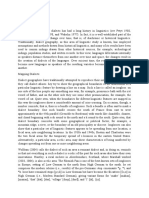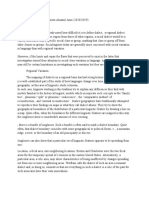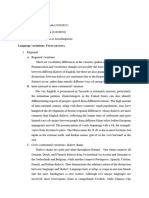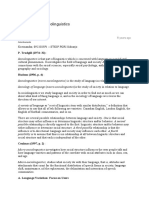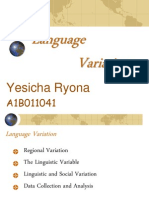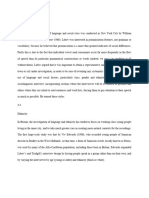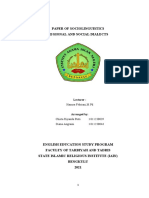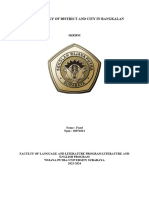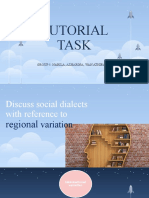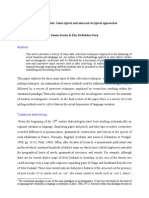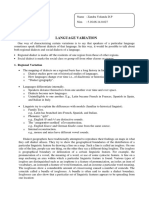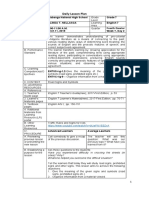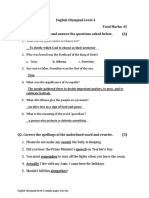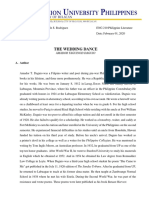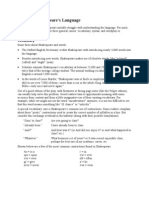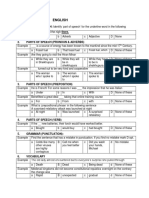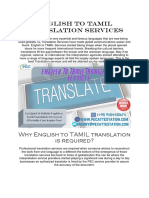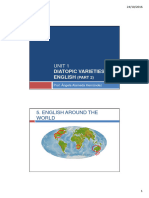Language Variation
As we have seen in previous chapters, languages vary in many ways. One way of characterizing
certain variations is to say that speakers of a particular language sometimes speak different dialects
of that language. Although I have already noted how difficult it is to define dialect, we may still find it
useful to use the term in our work in sociolinguistics, and even to extend its use from studies of
regional variation to those of social variation. In this way it would be possible to talk about both
regional dialects and social dialects of a language. Just as a regional dialect marks off the residents of
one region from those of other regions, a social dialect would be a variety associated with a specific
social class or group, marking that class or group off from other classes or groups. However, if this
further differentiation of varieties is to be successful, it will require us to be able to find linguistic
features which are associated with differences in classes or groups and, of course, to define what we
mean by these latter terms. Sociolinguists today are generally more concerned with social variation
in language than with regional variation. However, if we are to gain a sound understanding of the
various procedures used in studies of social variation, we should look at least briefly at previous work
in regional dialectology. That work points the way to understanding how recent investigations have
proceeded as they have. Studies of social variation in language grew out of studies of regional
variation. It was largely in order to widen the limits and repair the flaws that were perceived to exist
in the latter that investigators turned their attention to social-class variation in language. As we will
see, there may still be certain limitations in investigating such variation but they are of a different
kind. It is also important to note that even if there are limitations to this kind of work, many
sociolinguists regard it as being essentially what sociolinguistics is – or should be – all about (see pp.
14–15). In this view the study of language variation tells us important things about languages and
how they change. This chapter and the two that follow deal with such matters.
Regional Variation The mapping of dialects on a regional basis has had a long history in linguistics
(see Petyt, 1980, Chambers and Trudgill, 1998, and Wakelin, 1977). In fact, it is a well-established
part of the study of how languages change over time, i.e., of diachronic or historical linguistics.
Traditionally, dialect geography, as this area of linguistic study is known, has employed assumptions
and methods drawn from historical linguistics, and many of its results have been used to confirm
findings drawn from other historical sources, e.g., archeological findings, population studies, written
records. In this view languages differentiate internally as speakers distance themselves from one
another over time and space; the changes result in the creation of dialects of the languages. Over
sufficient time, the resulting dialects become new languages as speakers of the resulting varieties
become unintelligible to one another. So Latin became French in France, Spanish in Spain, Italian in
Italy, and so on. In this model of language change and dialect differentiation, it should always be
possible to relate any variation found within a language to the two factors of time and distance
alone; e.g., the British and American varieties, or dialects, of English are separated by over two
centuries of political independence and by the Atlantic Ocean; Northumbrian and Cockney English
are nearly 300 miles and many centuries apart. In each case, linguists working in this tradition try to
explain any differences they find with models familiar to the historical linguist, models which
incorporate such concepts as the ‘family tree’ (Latin has ‘branched’ into French, Spanish, and Italian),
phonemic ‘split’ (English /f/ and /v/ are now distinctive phonemes whereas once they were phonetic
variants, or allophones, of a single phoneme) or phonemic ‘coalescence’ (English ea and ee spellings,
as in beat and beet, once designated different pronunciations), the ‘comparative method’ of
reconstruction (English knave and German Knabe come from the same source), and ‘internal
reconstruction’ (though mouse and mice now have different vowel sounds, this was not always the
case). Dialect geographers have traditionally attempted to reproduce their findings on maps in what
they call dialect atlases. They try to show the geographical boundaries of the distribution of a
�particular linguistic feature by drawing a line on a map. Such a line is called an isogloss: on one side of
the line people say something one way, e.g., pronounce bath with the first vowel of father, and on
the other side they use some other pronunciation, e.g., the vowel of cat. Quite often, when the
boundaries for different linguistic features are mapped in this way the isoglosses show a considerable
amount of criss-crossing. On occasion, though, a number coincide; i.e., there is a bundle of
isoglosses. Such a bundle is often said to mark a dialect boundary. One such bundle crosses the south
of France from east to west approximately at the 45th parallel (Grenoble to Bordeaux) with words
like chandelle, chanter, and chaud beginning with a sh sound to the north and a k sound to the south.
Quite often, that dialect boundary coincides with some geographical or political factor, e.g., a
mountain ridge, a river, or the boundary of an old principality or diocese. Isoglosses can also show
that a particular set of linguistic features appears to be spreading from one


